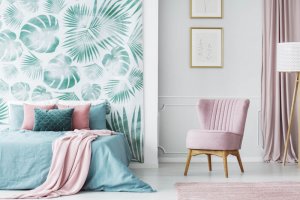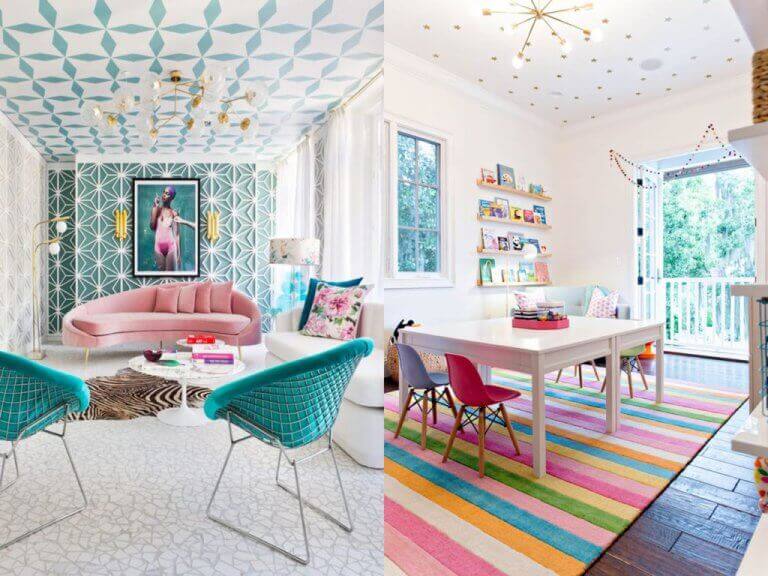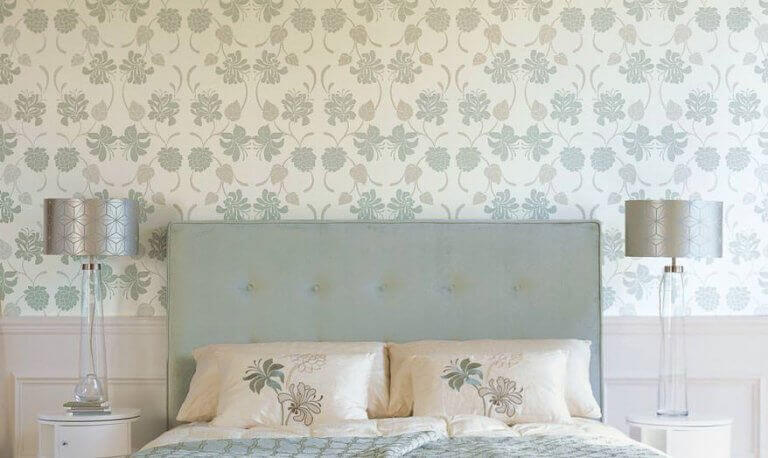Wallpaper - Advantages and Drawbacks

Thanks to its versatility, you can use wallpaper in any room of the house, whether in the living room, bedroom, or bathroom. It can give a splash of color and variety to the walls of your home, helping you to create a unique style. Here we’ll tell you about the advantages and drawbacks of using wallpaper.
During the wallpaper boom in the ’60s, it was typical to put up wallpaper on every wall in the room. But today, the trend is a little more selective. It’s more common to see wallpaper on just one wall, or in one specific room of the house.
Why has wallpaper made such a comeback? It’s due in part thanks to the improved techniques and ease of putting it up, advancements that have been made throughout the years. This means it’s now much easier to hang wallpaper.
Wallpaper, the latest trends

Using wallpaper to decorate your walls can allow you to be as creative as when you’re painting the walls. Whether you use more sober colors or vibrant designs, you can find almost any wallpaper you could wish for with classic prints, stripes, spots, flowered patterns or different shapes and pictures.
Depending on the texture of the wallpaper you choose, and the pattern and the colors, you will be able to modify the feel of the room and the decor however you want. With this in mind, you can produce some stunning visual effects with these means.
For instance, with striped wallpaper, you can make a room seem bigger. And on the other hand, with large shapes or with textured wallpaper you can make a big room seem cozier.
In the same way, if you choose bright, vibrant colors, you can make a boring room come to life. You’ll be able to transmit the idea of a fresh, youthful atmosphere.
When it comes to choosing wallpaper, make sure you think about what kind of impression you want to create in the room. You should consider how any new decorative additions will fit in with the existing decor and how you can keep a harmonious balance.
Take into account, for example, the fact that the more striking the wallpaper, the more it will draw the eye away from the furniture or other decorative objects in the room.
Try a sample first

To confirm that the wallpaper you choose is the right one, we advise that you ask for a sample first. It should be as big as possible (some shops will allow you to take the whole roll home).
If the pattern you choose has stripes or drawings, it would be a good idea to ask for a few repetitions of the decorative pattern. When you get home, stick up the samples with some tape or staples on the wall you’re thinking of wallpapering.
Check that the effect you want to create with the pattern is right. Take notice of how natural and artificial light affect the look.
This step is always a good idea since a color or pattern that looked unassuming in the shop can often overwhelm when you see it as large as life. So, don’t hold back – ask for all the samples you need. Once you’ve hung the wallpaper it will be too late to change your mind.
Wallpaper – advantages and drawbacks

Are you still not sure about using this great decorative resource? Well, here are a few extra tips to help guide you.
Advantages of wallpaper
- Easy and quick to put up, wallpaper also has the advantage of being low maintenance. However, remember that not all wallpapers will be of the same quality.
- You can put up wallpaper yourself in your home without coming across too many difficulties. Follow the instructions and make sure you have the right equipment, and you’ll be able to get a professional look with ease. Of course, some irregular walls or some special types of wallpaper need more attention and greater experience than others.
- Wallpapering is one of the quickest ways to transform a room. In less than a day you can change the whole feel of a room without the need for massive renovations. Just by putting up wallpaper with an oriental air, with stripes or bright colors, you can give a room its unique character.
- Here’s another of the advantages of wallpaper. Apart from being a decorative aid, it’s also a practical resource you can use to hide stains and marks on the wall. Just bear in mind that it won’t help you with any major imperfections in the walls, such as cracks or chips.
- Wallpaper helps to protect walls to a greater degree than paint does. Its ease of maintenance means that you can even wash it when necessary, depending on the quality you buy. Take into account as well that it can last for at least five to ten years.
What about the drawbacks?
There are some drawbacks inherent in this type of wall covering, as opposed to the advantages to wallpaper we mentioned above.
- One main drawback is that since it’s a paper-based product, wallpaper can easily become scratched. With that in mind, especially if it’s the first time you’re using wallpaper, we recommend you choose a high-quality paper.
- You should also know that wallpaper is quite expensive. So, consider what rooms of the house could benefit the most, as well as the technique that you will need to use to hang it correctly. By doing so, you won’t waste paper and increase the cost.
- Cheaper wallpapers that you can find on the market are generally thinner. When you hang them they can become moist and tear more easily. You should take special care in handling and putting up these kinds of wallpaper.
- Before putting up new wallpaper, you will need to remove any previous wallpaper. The walls should be smooth and ready. You can use water and soap for this, or a chemical stripper. This will be a little time-consuming.
- Another thing to consider. If the walls show damp or mold spots, you should treat them with an anti-mold product first. Otherwise, the stains could make holes in the wallpaper or even cause it to come away from the wall.
Well, what do you think after reading this? Will wallpaper be your next choice?
Thanks to its versatility, you can use wallpaper in any room of the house, whether in the living room, bedroom, or bathroom. It can give a splash of color and variety to the walls of your home, helping you to create a unique style. Here we’ll tell you about the advantages and drawbacks of using wallpaper.
During the wallpaper boom in the ’60s, it was typical to put up wallpaper on every wall in the room. But today, the trend is a little more selective. It’s more common to see wallpaper on just one wall, or in one specific room of the house.
Why has wallpaper made such a comeback? It’s due in part thanks to the improved techniques and ease of putting it up, advancements that have been made throughout the years. This means it’s now much easier to hang wallpaper.
Wallpaper, the latest trends

Using wallpaper to decorate your walls can allow you to be as creative as when you’re painting the walls. Whether you use more sober colors or vibrant designs, you can find almost any wallpaper you could wish for with classic prints, stripes, spots, flowered patterns or different shapes and pictures.
Depending on the texture of the wallpaper you choose, and the pattern and the colors, you will be able to modify the feel of the room and the decor however you want. With this in mind, you can produce some stunning visual effects with these means.
For instance, with striped wallpaper, you can make a room seem bigger. And on the other hand, with large shapes or with textured wallpaper you can make a big room seem cozier.
In the same way, if you choose bright, vibrant colors, you can make a boring room come to life. You’ll be able to transmit the idea of a fresh, youthful atmosphere.
When it comes to choosing wallpaper, make sure you think about what kind of impression you want to create in the room. You should consider how any new decorative additions will fit in with the existing decor and how you can keep a harmonious balance.
Take into account, for example, the fact that the more striking the wallpaper, the more it will draw the eye away from the furniture or other decorative objects in the room.
Try a sample first

To confirm that the wallpaper you choose is the right one, we advise that you ask for a sample first. It should be as big as possible (some shops will allow you to take the whole roll home).
If the pattern you choose has stripes or drawings, it would be a good idea to ask for a few repetitions of the decorative pattern. When you get home, stick up the samples with some tape or staples on the wall you’re thinking of wallpapering.
Check that the effect you want to create with the pattern is right. Take notice of how natural and artificial light affect the look.
This step is always a good idea since a color or pattern that looked unassuming in the shop can often overwhelm when you see it as large as life. So, don’t hold back – ask for all the samples you need. Once you’ve hung the wallpaper it will be too late to change your mind.
Wallpaper – advantages and drawbacks

Are you still not sure about using this great decorative resource? Well, here are a few extra tips to help guide you.
Advantages of wallpaper
- Easy and quick to put up, wallpaper also has the advantage of being low maintenance. However, remember that not all wallpapers will be of the same quality.
- You can put up wallpaper yourself in your home without coming across too many difficulties. Follow the instructions and make sure you have the right equipment, and you’ll be able to get a professional look with ease. Of course, some irregular walls or some special types of wallpaper need more attention and greater experience than others.
- Wallpapering is one of the quickest ways to transform a room. In less than a day you can change the whole feel of a room without the need for massive renovations. Just by putting up wallpaper with an oriental air, with stripes or bright colors, you can give a room its unique character.
- Here’s another of the advantages of wallpaper. Apart from being a decorative aid, it’s also a practical resource you can use to hide stains and marks on the wall. Just bear in mind that it won’t help you with any major imperfections in the walls, such as cracks or chips.
- Wallpaper helps to protect walls to a greater degree than paint does. Its ease of maintenance means that you can even wash it when necessary, depending on the quality you buy. Take into account as well that it can last for at least five to ten years.
What about the drawbacks?
There are some drawbacks inherent in this type of wall covering, as opposed to the advantages to wallpaper we mentioned above.
- One main drawback is that since it’s a paper-based product, wallpaper can easily become scratched. With that in mind, especially if it’s the first time you’re using wallpaper, we recommend you choose a high-quality paper.
- You should also know that wallpaper is quite expensive. So, consider what rooms of the house could benefit the most, as well as the technique that you will need to use to hang it correctly. By doing so, you won’t waste paper and increase the cost.
- Cheaper wallpapers that you can find on the market are generally thinner. When you hang them they can become moist and tear more easily. You should take special care in handling and putting up these kinds of wallpaper.
- Before putting up new wallpaper, you will need to remove any previous wallpaper. The walls should be smooth and ready. You can use water and soap for this, or a chemical stripper. This will be a little time-consuming.
- Another thing to consider. If the walls show damp or mold spots, you should treat them with an anti-mold product first. Otherwise, the stains could make holes in the wallpaper or even cause it to come away from the wall.
Well, what do you think after reading this? Will wallpaper be your next choice?







